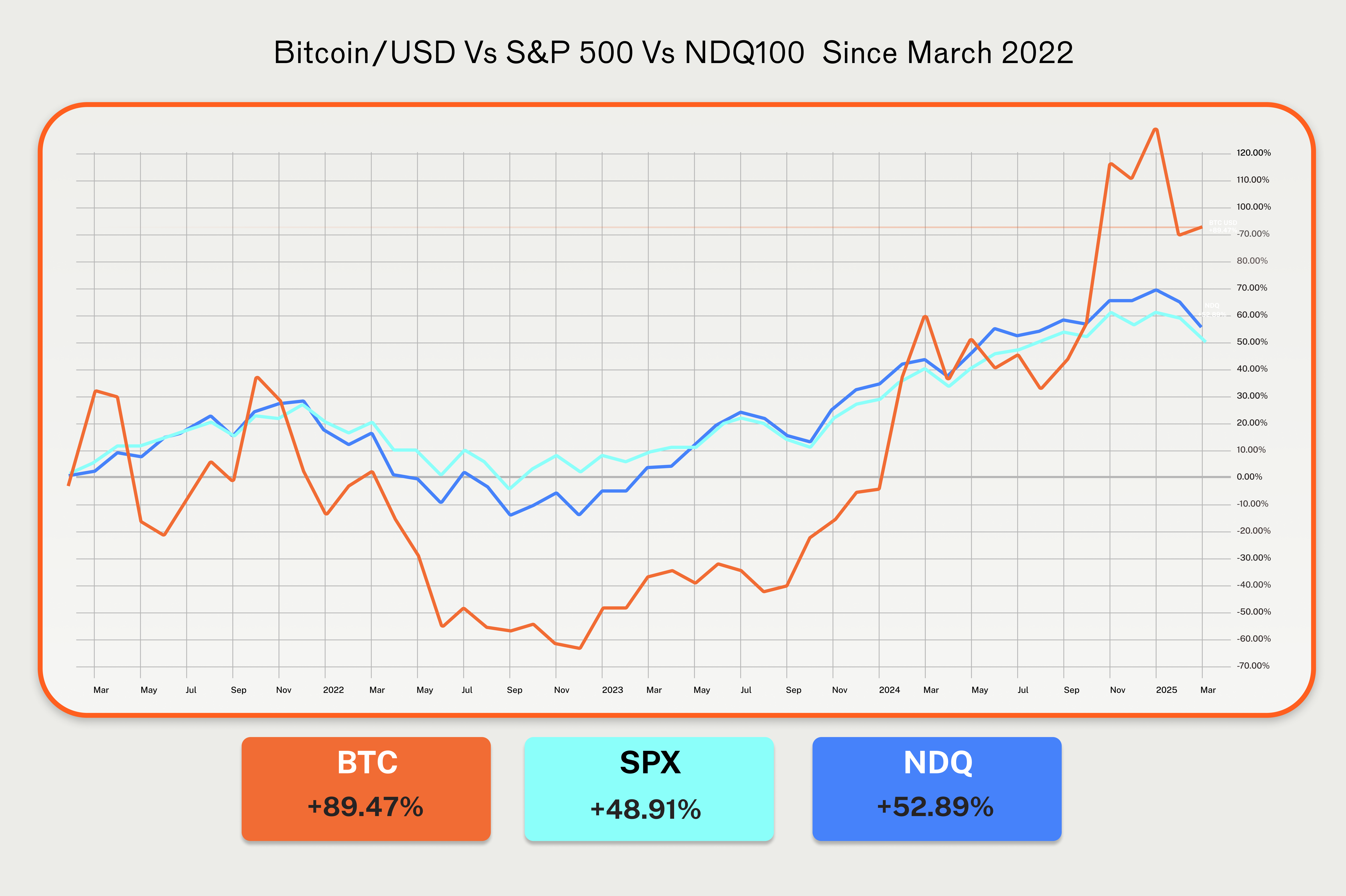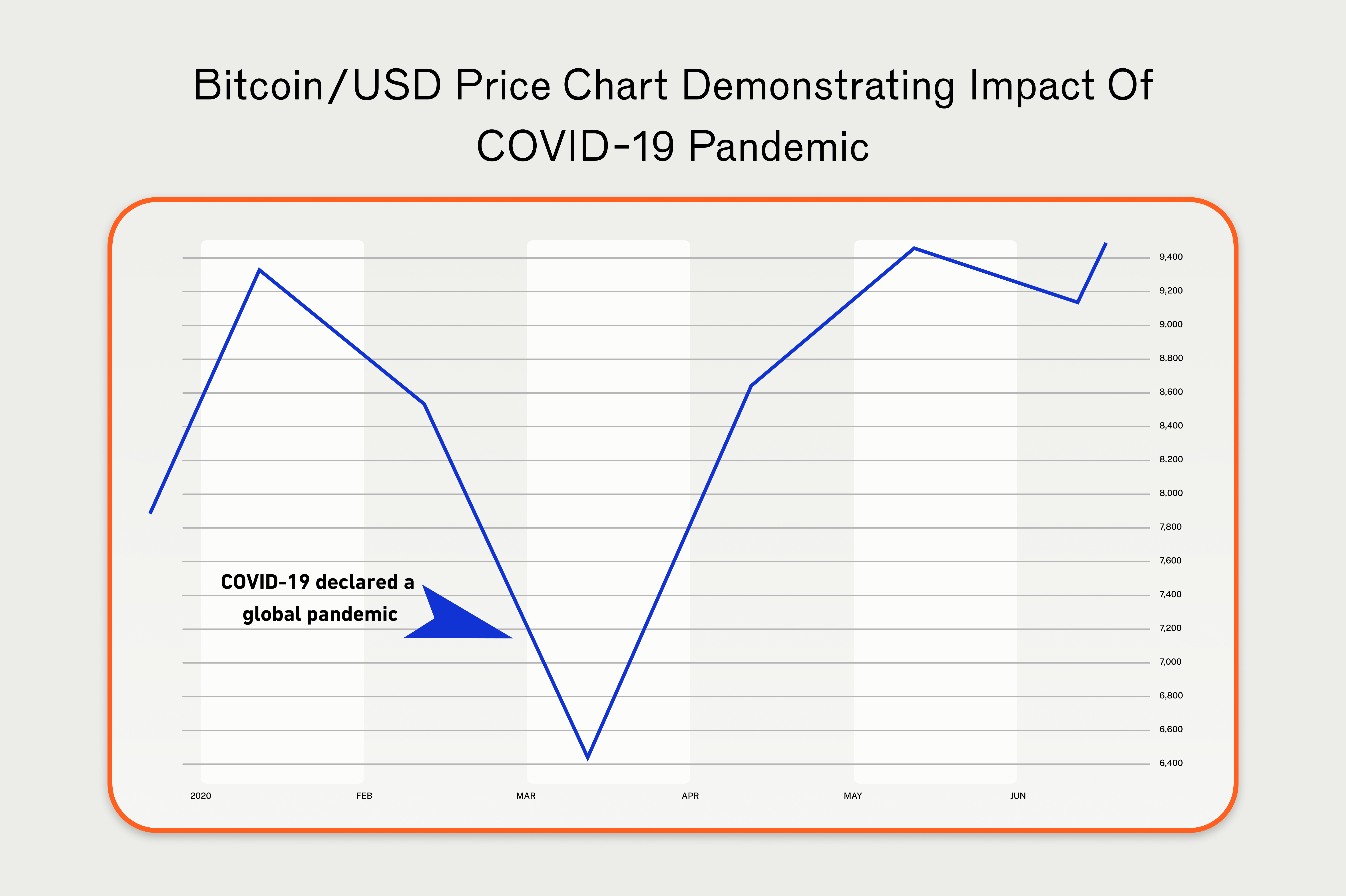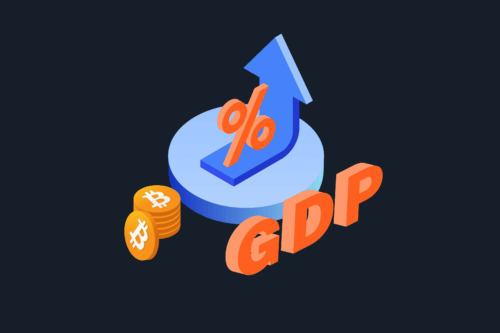
The crypto market has traditionally been less influenced by the macroeconomic landscape compared to more traditional financial assets. However, over time digital currencies have become more correlated with products like stocks and more likely to be shifted by broader economic trends. By looking at historic macro events, we can attempt to analyse which indicators may affect crypto market cycles and how this knowledge can help mitigate risk.
The macroeconomic landscape and crypto
As the crypto market blossomed into a trillion-dollar industry, its ties to TradFi grew tighter. With investment coming in from big banks and institutions (like BlackRock) and governments, equities and crypto have never been more correlated.
While assets such as Bitcoin are significantly more volatile than their TradFi counterparts, comparing the price performance of major indices to the crypto market shows some important similarities.

A major reason for this relationship is because traditional and crypto markets are impacted by many of the same macroeconomic factors.
A 2025 study in the International Review of Economics and Finance revealed that certain macro indicators have a notable correlation with Bitcoin’s price.
One such metric is the Producer Price Index (PPI), which measures the average price change in goods sold by domestic producers. This includes products from the agricultural, retail, transport and construction industries and is essentially one way of measuring inflation.
The 2025 investigation uncovered that a rise in PPI had a notable negative impact on Bitcoin’s short-term price. Similarly, the paper also found that a rising US Dollar — relative to other fiat currencies — had the same effect.
This is just one example of many demonstrating the powerful influence macroeconomics can have on the crypto market.
Historical macroeconomic events and their impact on the crypto market
2020 Covid pandemic and lockdowns
Significant economic uncertainty can cause mass selloffs for risk-on assets, and the Covid-19 pandemic was perhaps the most anxiety-inducing time for economies in recent memory. The once-in-a-generation event sent shockwaves across the world, as economies ground to a halt amid lockdowns and government intervention.
This caused one of the most significant short-term market declines in recent memory, with the shutdown culminating in the United States’ worst quarterly GDP contraction in recorded history — 32.9%
With production spiralling downwards and economic fears growing, the middle of March 2020 saw Bitcoin’s price fall 42%, dropping as low as US $5,227 within a fortnight.

Important to Remember
Macroeconomic events don’t affect all assets in the same way. For example, the Covid-19 lockdowns sent shockwaves through the crypto and stock markets. However, Australian and Global Bond markets maintained a positive 3-month return throughout this timeframe, according to Bloomberg.
2021 bull market amid record-low interest rates
The 2019-21 pandemic ushered in a new era — and with it came a particularly unique macroeconomic environment.
Global production was in some strife, with most nations only just emerging from lengthy lockdowns.
In an attempt to stimulate the economy and prevent mass unemployment, several major Governments enacted liberal fiscal policies that dropped interest rates to their lowest point in decades.
This, paired with significant supply chain issues, caused inflation to run rampant across the world. Yet, because economies were still reeling from the impact of lockdowns, Governments maintained these loose financial policies for as long as possible.
As we’ve learned earlier in this course, low interest rates in the United States can lead to greater global liquidity. Risky, volatile assets like crypto tend to thrive in such periods — and 2021 was no exception.
With GDP rising and the economy recovering, financial markets across the board recorded massive gains throughout the year. Bitcoin hit a new all-time high, while several altcoins experienced gains of 1,000% or more.

2022-3 rate hikes in the United States
The quantitative easing in reaction to Covid was an arguably necessary measure to keep jobs afloat amid a medical and economic crisis.
But while early inflation was an intended outcome of loose fiscal policy, it quickly ran out of control.
With the global supply chain still in tatters, CPI in the United States peaked at 9.1% in June 2022. Keep in mind, governments typically want this figure around the 2-3% mark.
Monetary tightening was necessary to pull inflation back under wraps — but the looming interest rate hikes sent the price of Bitcoin to the brink.
In June alone, BTC plummeted 37.8%, as the Feds raised the national cash rate 13 times between March 22 and June 23. Through this period, Bitcoin’s price fell from $50k USD to $25k USD.
While it’s worth noting other market-specific factors played a role — specifically the collapse of FTX and the de-pegging of TerraUSD — the macroeconomic environment was a key reason for the crypto winter of 2022-23.
How to integrate macroeconomic analysis into crypto trading
It’s easy to get sucked into social media sentiment and the common opinion of experts interpreting macroeconomic data.
While these can provide valuable insights, understanding these metrics yourself can help you form your own view of the global economic situation.
For example, it can be beneficial to stay clued into monthly inflation data reports coming out of the United States. Watching PCE, CPI and other figures can give you an idea of whether the Feds are likely to launch loose or tight fiscal policies at their next meeting.
Of course, it’s important to remember that macroeconomic data is only one piece of the puzzle. While it can help inform potential current and future market trends, there are many other factors to remain aware of when making investment decisions.
For example, a GDP contraction and potential recession would typically have a bearish outcome on the crypto market. However, a major technological upgrade or news event could override this sentiment — and vice versa.
Use macroeconomic analysis as a tool, rather than the arbiter of truth, to better your understanding of market cycles and mitigate certain risks.
Quiz
Disclaimer: The information on Swyftx Learn is for general educational purposes only and should not be taken as investment advice, personal recommendation, or an offer of, or solicitation to, buy or sell any assets. It has been prepared without regard to any particular investment objectives or financial situation and does not purport to cover any legal or regulatory requirements. Customers are encouraged to do their own independent research and seek professional advice. Swyftx makes no representation and assumes no liability as to the accuracy or completeness of the content. Any references to past performance are not, and should not be taken as a reliable indicator of future results. Make sure you understand the risks involved in trading before committing any capital. Never risk more than you are prepared to lose. Consider our Terms of Use and Risk Disclosure Statement for more details.


 Article read
Article read



